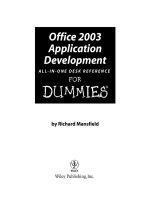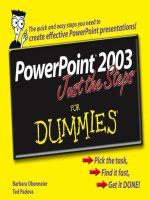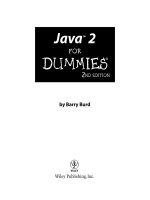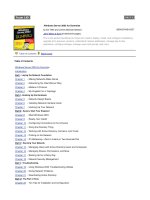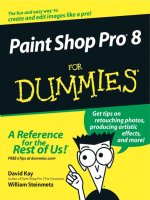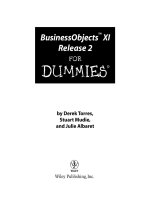uml 2 for dummies (2003)
Bạn đang xem bản rút gọn của tài liệu. Xem và tải ngay bản đầy đủ của tài liệu tại đây (7.39 MB, 441 trang )
.
.UML 2 for Dummies
by Michael Jesse Chonoles and James A. Schardt
ISBN:0764526146
Hungry Minds © 2003 (412 pages)
This plain English guide on building complex architectures with UML 2 shows how to
adjust to the UML 2 standard, extract key information from UML models, object modeling,
case modeling and more.
Table of Contents
UML 2 for Dummies
Introduction
Part I - UML and System Development
Chapter 1-What’s UML About, Alfie?
Chapter 2-Following Best Practices
Part II - The Basics of Object Modeling
Chapter 3-Objects and Classes
Chapter 4-Relating Objects That Work Together
Chapter 5-Including the Parts with the Whole
Chapter 6-Reusing Superclasses: Generalization and Inheritance
Chapter 7-Organizing UML Class Diagrams and Packages
Part III - The Basics of Use-Case Modeling
Chapter 8-Introducing Use-Case Diagrams
Chapter 9-Defining the Inside of a Use Case
Chapter 10-Relating Use Cases to Each Other
Part IV - The Basics of Functional Modeling
Chapter 11-Introducing Functional Modeling
Chapter 12-Capturing Scenarios with Sequence Diagrams
Chapter 13-Specifying Workflows with Activity Diagrams
Chapter 14-Capturing How Objects Collaborate
Chapter 15-Capturing the Patterns of Behavior
Part V - Dynamic Modeling
Chapter 16-Defining the Object’s Lives with States
Chapter 17-Interrupting the States by Hosting Events
Chapter 18-Avoiding States of Confusion
Part VI - Modeling the System’s Architecture
Chapter 19-Deploying the System’s Components
Chapter 20-Breaking the System into Packages/Subsystems
Part VII - The Part of Tens
Chapter 21-Ten Common Modeling Mistakes
Chapter 22-Ten Useful UML Web Sites
Chapter 23-Ten Useful UML Modeling Tools
Chapter 24-Ten Diagrams for Quick Development
Index
List of Figures
List of Tables
List of Listings
List of Sidebars
Back Cover
When it comes to modeling, this book is not just another pretty face! It guides you gently through the complexities of
UML, helps you adjust to the UML 2 standard, shows you how to extract key information from UML models, and more.
Before you know it, you’ll be communicating and developing systems like never before.
About the Authors
Michael Jesse Chonoles is former Chief of Methodology at the Advanced Concepts Center (ACC).
James A. Schardt is ACC’s Chief Technologist. Both belong to OMG Task Forces.
UML 2 for Dummies
by Michael Jesse Chonoles
and James A. Schardt
Published by
Wiley Publishing, Inc.
909 Third Avenue New York, NY 10022
www.wiley.com
Copyright © 2003 by Wiley Publishing, Inc., Indianapolis, Indiana
Published by Wiley Publishing, Inc., Indianapolis, Indiana
Published simultaneously in Canada
No part of this publication may be reproduced, stored in a retrieval system or transmitted in any form or by any
means, electronic, mechanical, photocopying, recording, scanning or otherwise, except as permitted under
Sections 107 or 108 of the 1976 United States Copyright Act, without either the prior written permission of the
Publisher, or authorization through payment of the appropriate per-copy fee to the Copyright Clearance
Center, 222 Rosewood Drive, Danvers, MA 01923, (978) 750-8400, fax (978) 646-8700. Requests to the
Publisher for permission should be addressed to the Legal Department, Wiley Publishing, Inc., 10475
Crosspoint Blvd., Indianapolis, IN 46256, (317) 572-3447, fax (317) 572-4447, e-mail:
Trademarks: Wiley, the Wiley Publishing logo, For Dummies, the Dummies Man logo, A Reference for the
Rest of Us!, The Dummies Way, Dummies Daily, The Fun and Easy Way, Dummies.com and related trade
dress are trademarks or registered trademarks of Wiley Publishing, Inc., in the United States and other
countries, and may not be used without written permission. All other trademarks are the property of their
respective owners. Wiley Publishing, Inc., is not associated with any product or vendor mentioned in this book.
Limit of Liability/Disclaimer of Warranty: While the publisher and author have used their best efforts in
preparing this book, they make no representations or warranties with respect to the accuracy or completeness
of the contents of this book and specifically disclaim any implied warranties of merchantability or fitness for a
particular purpose. No warranty may be created or extended by sales representatives or written sales
materials. The advice and strategies contained herein may not be suitable for your situation. You should
consult with a professional where appropriate. Neither the publisher nor author shall be liable for any loss of
profit or any other commercial damages, including but not limited to special, incidental, consequential, or other
damages.
For general information on our other products and services or to obtain technical support, please contact our
Customer Care Department within the U.S. at 800-762-2974, outside the U.S. at 317-572-3993, or fax
317-572-4002.
Wiley also publishes its books in a variety of electronic formats. Some content that appears in print may not be
available in electronic books.
Library of Congress Control Number: 2003105654
ISBN: 0-7645-2614-6
Manufactured in the United States of America
10 9 8 7 6 5 4 3 2 1
1B/QS/QX/QT/IN
Dedication
Michael dedicates this book to his wife Susann and to their son Zev, for their love, support, sacrifice, and
silliness.
Jim dedicates this book to his wife Martha for her sustaining love and encouragement, and to M. R. Bawa
Muhaiyaddeen as the guiding inspiration in his life.
Authors’ Acknowledgments
We would like to thank all the students whom we have taught over the years for their help in shaping our
ideas, and all the members of the Advanced Concepts Center, both past and present, for the chance to work
with some of the best practitioners in the business of systems and software development.
Together we acknowledge the absolutely necessary help, encouragement, and moral support of our Wiley
editors Terri Varveris and Kala Schrager.
Michael would like to thank a whole bunch of people who have helped him over the years, and specifically with
this book: Susann Chonoles for teaching him how to write better and for help in proofreading; Zev Chonoles,
for being a Test Dummy For Dummies and reading his chapters; his managers Bob DeCarli, Mike Duffy, and
Barbara Zimmerman, who encouraged him even when he messed up; and his high-school buddies Joseph
Newmark, Jeffrey Landsman, and Barry Salowitz, who keep on telling him what he’s doing wrong. It goes
without saying that he’s grateful to his parents for everything.
He’d also like to acknowledge Jim Schardt for his work toward understanding UML in all its forms, and Lou
Varveris for his insight, recommendations, and for access to the Popkin’s System Architect tool. He’s also
grateful to all the members of the OMG ADTF and the UML Gurus for their technical advice, encouragement,
and support over the years—especially Cris Kobryn, Jim Odell, Jim Rumbaugh, Philippe Desfray, and Bran
Selic.
Jim would like to thank a number of individuals who helped him develop his knowledge and skills over the
years: David Oliver for his systems perspective; Michael Kamfonas for his data-warehouse development
insights; Michael Chonoles for his work toward understanding UML in all its forms; Jim Rumbaugh and Fred
Eddy for their mentoring on object-oriented analysis; and Michael Blaha and William Premerlani for their
guiding hand in developing database-design techniques using UML.
Publisher’s Acknowledgments
We’re proud of this book; please send us your comments through our online registration form located at
www.dummies.com/register/.
Some of the people who helped bring this book to market include the following:
Acquisitions, Editorial, and Media Development
Project Editor: Kala Schrager
Acquisitions Editor: Theresa Varveris
Senior Copy Editor: Barry Childs-Helton
Technical Editor: Lou Varveris
Editorial Manager: Kevin Kirschner
Media Development Supervisor: Richard Graves
Editorial Assistant: Amanda Foxworth
Cartoons: Rich Tennant, www.the5thwave.com
Production
Project Coordinators: Kristie Rees, Dale White
Layout and Graphics: Seth Conley, Kelly Emkow, Carrie Foster, LeAndra Hosier, Stephanie D. Jumper,
Michael Kruzil, Mary Gillot Virgin
Proofreaders: Laura Albert, Susan Moritz, Dwight Ramsey, TECHBOOKS Production Services
Indexer: TECHBOOKS Production Services
Publishing and Editorial for Technology Dummies
Richard Swadley, Vice President and Executive Group Publisher
Andy Cummings, Vice President and Publisher
Mary C. Corder, Editorial Director
Publishing for Consumer Dummies
Diane Graves Steele, Vice President and Publisher
Joyce Pepple, Acquisitions Director
Composition Services
Gerry Fahey, Vice President of Production Services
Debbie Stailey, Director of Composition Services
About the Authors
Michael Jesse Chonoles: An established system developer, educator, author, and consultant, Michael has
done just about everything that you can do in software and system development—business, requirements,
and software analysis; software, system, and architectural design; coding in many languages; testing and
quality control—right through marketing, packing, and shrink-wrapping the software. His titles include Chief of
Methodology for the Advanced Concepts Center (ACC), Software Development Practice Area Director,
Consulting Analyst, Software Standard and Practices Manager, Test Director, Senior Software Engineer,
several varieties of Team/Project Lead/Staff, and (his personal favorite) Wizard. At the Advanced Concepts
Center, he was responsible for the content and direction of its Object-Oriented and Requirements-Gathering
Curricula as well as its Software Development Practice. Together with his co-author, he constructed a
software/ system-development methodology, CADIT, which was an early attempt to combine agile techniques
with aerospace discipline. He continues his quest to make the complicated simple, while increasing the
professional rigor, quality, and productivity of his audience’s working lives.
Michael has been involved in many aspects of UML, even before there was a UML. He’s been an active
member of the UML RTF (Revision Task Force) at OMG—and frequently writes, lectures, speaks, and
suggests UML topics.
Michael has an MSE in Systems Engineering from the University of Pennsylvania and BSs in Math and
Physics from MIT. He can be contacted at
James A. Schardt: As the Chief Technologist with the Advanced Concepts Center, James provides 24 years of
experience and a firm grounding in object-oriented development, data warehousing, and distributed systems.
He teaches and mentors Fortune 50 companies in the U.S. and abroad. His many years of practice in
object-oriented systems, database design, change management, business engineering, instructional design,
systems-architecture assessment, business engineering, and team facilitation bring a wealth of experience to
his assignments.
He authors papers on data warehousing and object technology and also wrote a column for Report on
Object-Oriented Analysis and Design. James speaks at The Data Warehouse Institute’s world conferences on
a regular basis. He delivers a two-day presentation on collecting and structuring the requirements for
enterprise data-warehouse development.
James is always looking for ways to improve the way that we develop systems and software. Clients request
him by name to deliver his exceptional knowledge transfer skills, both in the classroom and as a mentor on
projects. Over the years, James has managed major research and development programs, invented new
systems methods, developed “intelligent” information-access systems, and provided unique insights into
clients’ difficult development problems.
James has an MSE in Systems Engineering from the University of Pennsylvania. He can be reached via
Introduction
If, like us, you’re a software developer or computer professional of some sort, you probably have to deal with
the stereotype that developers can’t express themselves among normal humans about normal things.
Unfortunately, this book may not help you with that particular challenge, but it can help improve your ability to
communicate with other developers about technical matters. UML (Unified Modeling Language) is a graphical
language that is suit-able to express software or system requirements, architecture, and design. You can use
UML to communicate with other developers, your clients, and increasingly, with automated tools that generate
parts of your system.
If you’re already familiar with UML, you know how powerful and expressive it is — but don’t be surprised if
you’re impressed all over again by the new features of UML 2. Perhaps you found some parts of UML too
complicated or the apparent benefit too obscure. Well, the UML gurus have revamped UML in many areas —
making easier to express yourself exactly and clearly — and they have also added fresh capabilities for the
latest software- and system-development problems that you’re facing.
But because your problems are complex — and your solutions are some-times even more complex — UML is
not always simple to learn. It’s a large and multifaceted language, capable of helping in all areas of
development, from analysis to test as well as from database to embedded-real-time. To some, it’s a
bewildering array of diagrams and symbols. Sometimes it might appear to you that the UML gurus purposely
make it too complicated (and with UML 2, even more so) for the rest of us to understand.
Bottom line: You need a practical, experience-based guide to the ins and outs of this new language. Let this
book be that guide. We boiled down our experiences with UML (in many environments) and our skills as
educators to focus on key UML capabilities that you need first to be more productive.
So, with straightforward English and concrete examples, we give you a leg up on expressing yourself and
being more creative on the job. (Hey, it could help you get a raise — just don’t expect us to help you get a
date.)
How to Use This Book
There’s a right way and a wrong way to use this book. Luckily (like its subject, UML 2), this book is
remarkably versatile. If you’re a traditionalist, you can read it from cover to cover (although you’ll probably stop
at the index). That’s a great approach if you’re really new to UML. If you’re familiar with earlier versions of
UML, you can skip around looking for the new UML 2 stuff. You may miss our (ahem) great insights into the
rest of UML, but you know why you bought the book — do what works. Using any of these techniques will get
you familiar with your book so that you can count on it to help unstick you if you hit a snag with UML.
After you make friends with your book, you’ll probably find yourself taking advantage of its just-in-time
features. With just a bit of page flipping, you’ll be at a section that’s full of examples, tips, techniques, and
warnings that will help you with your UML modeling.
There are other ways to use this book . . . and some of them are wrong ways. It’s not going to work that well
as a doorstop (wrong size), and it probably won’t impress your date (unless you’re dating a developer who’s
new to UML). However, it’ll look great on your bookshelf — silently conveying to your boss your desire to
improve — but if you never open it, you won’t get the full benefit.
Some Presumptuous Assumptions
If you’re reading this, we can safely assume that not only have you already opened the book, you’re probably
also a developer of software, systems, or databases, and you want to read or write UML 2 diagrams. Perhaps
you’re a manager or business analyst in the same boat.
We won’t assume that you know any particular computer language, although knowing one will certainly help.
For the most part, we assume that you fall into one of two major categories: Either you’re a modeler (with a
yen to communicate requirements or how you think the world works), or you’re a developer (looking to explore
alternative designs or communicate your results). Either way, this book is for you.
We assume that you’re capable of using a tool to draw UML diagrams — we don’t care which one. If the only
tool that you have your hands on is in your hands (as opposed to on-screen), you won’t be at a disadvantage
when you use this book (although your diagrams won’t be quite as tidy if you’re drawing with a stick on wet
sand). You may even be better off doing some diagrams by hand; electronic UML tools are often expensive
and may not yet be up to date with all the neat UML 2 features that we cover. If you’re itching for a high-tech
UML tool, take a look at Chapter 23 where we list of some of the more useful examples (in all price
categories).
How This Book Is Organized
Here’s your first practical hint about using UML: Put about five to nine major elements on a diagram — no
more. Studies have shown (we’ve always wondered who does this type of study) that most people have a hard
time comprehending more than about nine elements at a time. Likewise, when designing this book, we
decided to follow our own advice and to divide the book into just seven parts.
Remember that you don’t have to read this book in order. Just choose the parts and chapters that you need at
the time.
Part I: UML and System Development
If you want to know what UML is (and why knowing it is useful), this is the place to go; it covers the basics of
UML and how it can be used. You’ll also find some common principles for communicating or developing
systems with UML. These principles guided the UML gurus when they created UML; the same principles can
guide you to effective use of it. Ways to apply these principles crop up throughout the book.
Part II: The Basics of Object Modeling
When you model by using UML, the basics are the things (or objects) that you draw and the relationships
among them. You’ll find information on classes, objects, associations, inheritances, and generalizations. No
matter what type of development you do, understanding this part will probably be essential.
Part III: The Basics of Use-Case Modeling
Use cases (detailed real-world examples) allow you to understand and communicate the purpose of a system
or its components. They are great for organizing your thoughts — and your system — when you want to get a
value-added product out the door.
Part IV: The Basics of Functional Modeling
When the objects in your system get busy and you want to explain the details of their complex behavior,
you’ll need a technique to do so. UML supplies several to choose from — and this part explains and compares
them. You’ll see several different types of interaction diagrams (such as sequence, communication, and
activity) in action, and discover how to combine them to create solutions, patterns, and frameworks. If you’re
experienced with UML, you’ll find lots of new UML 2 stuff in this part.
Part V: Dynamic Modeling
Your objects are more that just clumps of data stuck together with a few functions. The objects that you
develop are more like living things; they remember the past and live their lives by changing their states in
response to incoming events. In this part, you can make sure that they get a life — and that you know how to
explain it. Come to this part for state charts.
Part VI: Modeling the System?s Architecture
Whether you’re an architect, programmer, or construction worker, you build complex architectures. Computer
systems and software applications distribute themselves across different hardware platforms — and spread
throughout the Internet. This part outlines steps that you can use to design your systems for their mission by
using system plans, packaging, and subsystems.
Part VII: The Part of Tens
Everyone enjoys making lists (and daydreaming that they’ll be read aloud, backward, on late-night talk shows).
Here are our top-ten lists of useful tips, tools, Web sites, and diagrams. They’re likely to be your top-tens, too.
Icons Used in This Book
Appropriately for a book about graphical communication (even if it is software-oriented), there are signposts
throughout to help you find your way.
UML2 This icon identifies the really new stuff in UML 2. Not every modified feature will get this flag, but it does
alert those who are familiar with UML 1.x that something’s really different here.
Tip Here’s a simpler way of doing something that can make it easier than the typical approach. Think of it as
a shortcut to better UML.
Remember UML can be a maze — and it can be amazing. These are gentle reminders to reinforce important
points.
Warning If you see this icon but ignore it, you’ll be in good company but a bad mood.
Technical Stuff When you see this icon, you know that we thought the associated material really interesting
— but every time we tell people enthusiastically about it, they fall asleep. Skip these sections if you want.
Where to Go from Here
Okay, you’re now ready to explore the world of UML 2 modeling. Relax. You’ve got the tools that you need in
your head and your hands (one of them is this book), and it’s safe to explore.
So, go ahead and express yourself with the power of UML 2.
Part I: UML and System Development
Chapter List
Chapter 1:What’s UML About, Alfie?
Chapter 2: Following Best Practices
Part Overview
In this part . . .
Building systems or software isn’t that tough if you can communicate with your clients, co-workers, managers,
and tools. Unfortunately, as your problems get harder and more complex, the risks that emerge from
miscommunication become greater — and more severe when they do crop up.
Fortunately, there’s a straightforward, visual language that you can use that will help promote more precise
and more efficient communication about the nature of your system in all its aspects — software, requirements,
architectures, designs, design patterns, and implementations. This language is UML, the Unified Modeling
Language. The newest version, UML 2, has become more powerful and more useful than ever.
Starting here, we cover the basics of UML. You find out how it may fit your situation, how and when you can
use it, and what it’s good for. We give you just as much background in history, terminology, and basic
principles as you’ll need to take advantage of UML’s highly productive features.
Chapter 1: What’s UML About, Alfie?
Overview
In This Chapter
Understanding the basics of UML
Exploring the whys and whens of UML diagrams
So you’ve been hearing a lot about UML, and your friends and colleagues are spending some of their time
drawing pictures. And maybe you’re ready to start using UML but you want to know what it’s all about first.
Well, it’s about a lot of things, such as better communication, higher productivity, and also about drawing
pretty pictures. This chapter introduces you to the basics of UML and how it can help you.
Introducing UML
The first thing you need to know is what the initials UML stand for. Don’t laugh—lots of people get it wrong,
and nothing brands you as a neophyte faster. It’s not the Universal Modeling Language, as it doesn’t intend to
model everything (for example, it’s not very good for modeling the stock market; otherwise we’d be rich by
now). It’s also not the Unified Marxist-Leninists, a Nepalese Political party (though we hope you’ll never get
that confused). It is the University of Massachusetts Lowell—but not in this context. UML really stands for the
Unified Modeling Language.
Well, maybe that’s not the most important thing to know. Probably just as important is that UML is a
standardized modeling language consisting of an integrated set of diagrams, developed to help system and
software developers accomplish the following tasks:
Specification
Visualization
Architecture design
Construction
Simulation and Testing
Documentation
UML was originally developed with the idea of promoting communication and productivity among the
developers of object-oriented systems, but the readily apparent power of UML has caused it to make inroads
into every type of system and software development.
Appreciating the Power of UML
UML satisfies an important need in software and system development. Modeling—especially modeling in a
way that’s easily understood—allows the developer to concentrate on the big picture. It helps you see and
solve the most important problems now, by preventing you from getting distracted by swarms of details that
are better to suppress until later. When you model, you construct an abstraction of an existing real-world
system (or of the system you’re envisioning), that allows you to ask questions of the model and get good
answers—all this without the costs of developing the system first.
After you’re happy with your work, you can use your models to communicate with others. You may use your
models to request constructive criticism and thus improve your work, to teach others, to direct team members’
work, or to garner praise and acclamation for your great ideas and pictures. Properly constructed diagrams
and models are efficient communication techniques that don’t suffer the ambiguity of spoken English, and
don’t overpower the viewer with overwhelming details.
Abstracting out the essential truth
The technique of making a model of your ideas or the world is a use of abstraction. For example, a map is a
model of the world—it is not the world in miniature. It’s a conventional abstraction that takes a bit of training or
practice to recognize how it tracks reality, but you can use this abstraction easily. Similarly, each UML diagram
you draw has a relationship to your reality (or your intended reality), and that relationship between model and
reality is learned and conventional. And the UML abstractions were developed as conventions to be learned
and used easily.
If you think of UML as a map of the world you see—or of a possible world you want—you’re not far off. A
closer analogy might be that of set of blueprints that show enough details of a building (in a standardized
representation with lots of specialized symbols and conventions) to convey a clear idea of what the building is
supposed to be.
The abstractions of models and diagrams are also useful because they suppress or expose detail as needed.
This application of information hiding allows you to focus on the areas you need—and hide the areas you
don’t. For example, you don’t want to show trees and cars and people on your map, because such a map
would be cumbersome and not very useful. You have to suppress some detail to use it.
Technical Stuff You’ll find the word elide often in texts on UML—every field has its own jargon. Rumor has it
that elide is a favorite word of Grady Booch, one of the three methodologists responsible for the original
development of UML. Elide literally means to omit, slur over, strike out, or eliminate. UML uses it to describe
the ability of modelers (or their tools) to suppress or hide known information from a diagram to accomplish a
goal (such as simplicity or repurposing).
Chapter 2 tells you more about using these concepts of information hiding and abstraction during development.
Selecting a point of view
UML modeling also supports multiple views of the same system. Just as you can have a political map, a relief
map, a road map, and a utility map of the same area to use for different purposes—or different types of
architectural diagrams and blueprints to emphasize different aspects of what you’re building—you can have
many different types of UML diagrams, each of which is a different view that shows different aspects of your
system.
UML also allows you to construct a diagram for a specialized view by limiting the diagram elements for a
particular purpose at a particular time. For example, you can develop a class diagram—the elements of which
are relevant things and their relationships to one another—to capture the analysis of the problem that you
have to solve, to capture the design of your solution, or to capture the details of your implementation.
Depending on your purpose, the relevant things chosen to be diagram elements would vary. During analysis,
the elements that you include would be logical concepts from the problem and real world; during design, they
would include elements of the design and architectural solution; and during implementation, they would
primarily be software classes.
A use case diagram normally concentrates on showing the purposes of the system (use cases) and the users
(actors). We call a use case diagram that has its individual use cases elided (hidden) a context diagram,
because it shows the system in its environment (context) of surrounding systems and actors.
Choosing the Appropriate UML Diagram
UML has many diagrams—more, in fact, than you’ll probably need to know. There are at least 13 official
diagrams (actually the sum varies every time we count it) and several semiofficial diagrams. Confusion can
emerge because UML usually allows you to place elements from one diagram on another if the situation
warrants. And the same diagram form, when used for a different purpose, could be considered a different
diagram.
In Figure 1-1, we’ve constructed a UML class diagram that sums up all the major types of UML diagrams
(along with their relationships), using the principle of generalization, which entails organizing items by
similarities to keep the diagram compact. (See Chapter 2 for more information on generalization.)
Figure 1-1: A class diagram of UML diagrams.
In Figure 1-1, the triangular arrows point from one diagram type to a more general (or more abstract) diagram
type. The lower diagram type is a kind-of or sort-of the higher diagram type. Thus a Class Diagram is a kind of
Structural Diagram, which is a kind of Diagram. The diagram also uses a dashed arrow to indicate a
dependency—some diagrams reuse the features of others and depend on their definition. For example, the
Interaction Overview Diagram depends on (or is derived from) the Activity Diagram for much of its notation. To get
a line on how you might use UML diagrams, check out the summary in Table 1-1.
Slicing and dicing UML diagrams
There are many ways of organizing the UML diagrams to help you understand how you may best use them.
The diagram in Figure 1-1 uses the technique of organization by generalization (moving up a hierarchy of
abstraction) and specialization (moving down the same hierarchy in the direction of concrete detail). (See
Chapter 6 for more on generalization and specialization.) In Figure 1-1, each diagram is a subtype of (or
special kind of) the diagram it points to. So—moving in the direction of increasing abstraction—you can
consider a communication diagram from two distinct angles:
It’s a type of interaction diagram, which is a type of behavioral diagram, which is a type of
diagram.
It’s derived from a composite structure diagram, which is a kind of structural diagram, which
is a type of diagram.
After you get some practice at creating and shaping UML diagrams, it’s almost second nature to determine
which of these perspectives best fits your purpose.
This general arrangement of diagrams that we used in our Figure 1-1 is essentially the same as the UML
standard uses to explain and catalog UML diagrams—separating the diagrams into structural diagrams and
behavioral diagrams. This is a useful broad categorization of the diagrams, and is reflected in the
categorizations in Table 1-1:
Structural diagrams: You use structural diagrams to show the building blocks of your
system—features that don’t change with time. These diagrams answer the question, What’s
there?
Behavioral diagrams: You use behavioral diagrams to show how your system responds to
requests or otherwise evolves over time.
Interaction diagrams: An interaction diagram is actually a type of behavioral diagram. You
use interaction diagrams to depict the exchange of messages within a collaboration (a group
of cooperating objects) en route to accomplishing its goal.
Table 1-1: UML 2 Diagrams and Some of Their Uses
CategoryType of
Diagram
PurposeWhere to
Find More
Information
Structural
diagram
Class diagramUse to show real-world
entities, elements of analysis
and design, or
implementation classes and
their relationships
Chapter 7
Structural
diagram
Object diagramUse to show a specific or
illustrative example of objects
and their links. Often used to
indicate the conditions for an
event, such as a test or an
operation call
Chapter 7
Structural
diagram
Composite
structure
diagram
Use to show the how
something is made.
Especially useful in complex
structures-of-structures or
component-based design
Chapter 5
Structural
diagram
Deployment
diagram
Use to show the run-time
architecture of the system,
the hardware platforms,
software artifacts (deliverable
or running software items),
and software environments
(like operating systems and
virtual machines)
Chapter 19
Structural
diagram
Component
diagram
Use to show organization and
relationships among the
system deliverables
Chapter 19
Structural
diagram
Package
diagram
Use to organize model
elements and show
dependencies among them
Chapter 7
Behavioral
diagram
Activity diagramUse to the show data flow
and/ or the control flow of a
behavior Captures workflow
among cooperating objects
Chapter 18
Behavioral
diagram
Use case
diagram
Use to show the services that
actors can request from a
system
Chapter 8
Behavioral
diagram
State machine
diagram /
Protocol state
machine
diagram
Use to show the life cycle of a
particular object, or the
sequences an object goes
through or that an interface
must support
Chapter 18
Interaction
diagram
Overview
diagram
Use to show many different
inter- action scenarios
Chapter 13
CategoryType of
Diagram
PurposeWhere to
Find More
Information
the same collaboration (a set
of elements working together
to accomplish a goal)
Interaction
diagram
Sequence
diagram
Use to focus on message
exchange between a group of
objects and the order of the
messages
Chapter 13
Interaction
diagram
Communication
diagram
Use to focus on the
messages between a group
of objects and the underlying
relationship of the objects
Chapter 14
Interaction
diagram
Timing diagramUse to show changes and
their relationship to clock
times in real-time or
embedded systems work
Rarely used,
so we refer
you to the
UML
specification
Because UML is very flexible, you’re likely to see various other ways of categorizing the diagrams. The
following three categories are popular:
Static diagrams: These show the static features of the system. This category is similar to
that of structural diagrams.
Dynamic diagrams: These show how your system evolves over time. This category covers
the UML state-machine diagrams and timing diagrams.
Functional diagrams: These show the details of behaviors and algorithms—how your
system accomplishes the behaviors requested of it. This category includes use-case,
interaction, and activity diagrams.
You can employ UML diagrams to show different information at different times or for different purposes. There
are many modeling frameworks, such as Zachman or DODAF (Department of Defense’s Architecture
Framework) that help system developers organize and communicate different aspects of their system. A
simple framework for organizing your ideas that is widely useful is the following approach to answering the
standard questions about the system:
Who uses the system? Show the actors (the users of the system) on their use case
diagrams (showing the purposes of the system).
What is the system made of? Draw class diagrams to show the logical structure and
component diagrams to show the physical structure.
Where are the components located in the system? Indicate your plans for where your
components will live and run on your deployment diagrams.
When do important events happen in the system? Show what causes your objects to react
and do their work with state diagrams and interaction diagrams.
Why is this system doing the things it does? Identify the goals of the users of your system
and capture them in use cases, the UML construct just for this purpose.
How is this system going to work? Show the parts on composite structure diagrams and use
communication diagrams to show the interactions at a level sufficient for detailed design and
implementation.
Automating with Model-Driven Architecture (MDA)
Model-driven architecture (MDA) is new way to develop highly automated systems. As UML tools become
more powerful, they make automation a real possibility much earlier in the process of generating a system.
The roles of designer and implementer start to converge. UML provides you with the keys to steer your
systems and software development toward new horizons utilizing model-driven architectures.
In the past, after the designer decides what the system would look like—trading off the design approach
qualities such as performance, reliability, stability, user-friendliness—the designer would hand the models off
to the developer to implement. Much of that implementation is difficult, and often repetitious. As one part of an
MDA approach to a project, UML articulates the designer’s choices in a way that can be directly input into
system generation. The mechanical application of infrastructure, database, user interface, and middleware
interfaces (such as COM, CORBA, .NET) can now be automated.
Because UML 2 works for high-level generalization or for showing brass-tacks detail, you can use it to help
generate high-quality, nearly complete implementations (code, database, user-interface, and so on) from the
models.
In MDA, the Development Team is responsible for analysis, requirements, architecture, and design, producing
several models leading up to a complete, but Platform-Independent Model (PIM). Then UML and MDA tools
can generate a Platform-Specific Model (PSM) based on the architecture chosen and (after some tweaking)
produce the complete application.
This approach promises to free the development team from specific middleware or platform vendors. When a
new architecture paradigm appears—and it will—the team can adopt it without going back to Square One for a
complete redevelopment effort. The combination of UML and MDA also promises to free development teams
from much of the coding work. Although the required UML models are much more specific than most
organizations are used to, their use will change the way developers make systems.
With the advent of MDA and its allied technologies, UML becomes a sort of executable blueprint—the
descriptions, instructions, and the code for your system in one package. Remember it all begins with UML.
Identifying Who Needs UML
Broadly speaking, UML users fall into three broad categories:
Modelers: Modelers try to describe the world as they see it—either the world as is, whether
it’s a system, a domain, an application, or a world they imagine to come. If you want to
document a particular aspect of some system, then you’re acting as a modeler—and UML is
for you.
Designers: Designers try to explore possible solutions, to compare, to trade off different
aspects, or to communicate approaches to garner (constructive) criticism. If you want to
investigate a possible tactic or solution, then you’re acting as a designer—and UML is for
you.
Implementers: Implementers construct solutions using UML as part of (or as the entire)
implementation approach. Many UML tools can now generate definitions for classes or
databases, as well as application code, user interfaces, or middleware calls. If you’re
attempting to get your tool to understand your definitions, then you’re an Implementer—and
(you guessed it) UML is for you.
To understand how you can benefit from UML, it will help to know how and why it was developed. It’s based
on successful and working techniques proposed by groups of Software Technology Vendors before the Object
Management Group, and voted upon by the members.
Dispelling Misconceptions about UML
Many developers have several misconceptions about UML. Perhaps you do too, but after reading this book,
you’ll have the misconceptions dispelled:
UML is not proprietary. Perhaps UML was originally conceived by Rational Software, but now
it’s owned by OMG, and is open to all. Many companies and individuals worked hard to
produce UML 2. Good and useful information on UML is available from many sources
(especially this book).
UML is not a process or method. UML encourages the use of modern object-oriented
techniques and iterative life cycles. It is compatible with both predictive and agile control
approaches. However, despite the similarity of names, there is no requirement to use any
particular “Unified Process”—and (depending on your needs) you may find such stuff
inappropriate anyway. Most organizations need extensive tailoring of existing methods
before they can produce suitable approaches for their culture and problems.
UML is not difficult. UML is big, but you don’t need to use or understand it all. You are able to
select the appropriate diagrams for you needs and the level of detail based on you target
audience. You’ll need some training and this book (of course), but UML is easy to use in
practice.
UML is not time-consuming. Properly used, UML cuts total development
time and expenses as it decreases communication costs and increases
understanding, productivity, and quality.
The evolution of UML
In the B.U. days (that’s Before UML), all was chaos, because object-oriented developers did not
understand each other’s speech. There were over 50 different object-oriented graphical notations
available (I actually counted), some of them even useful, some even had tool support. This confusion,
interfered with adoption of object-oriented techniques, as companies and individuals were reluctant to
invest in training or tools in such a confusing field.
Still the competition of ideas and symbols did cause things to improve. Some techniques were clearly
more suited to the types of software problems that people were having. Methodologists started to
adopt their competitors’ useful notation. Eventually some market leaders stood out.
In October 1994, Jim Rumbaugh of the Object Modeling Technique (OMT) and Grady Booch of the
Booch Method started to work together on unifying their approach. Within a year, Ivar Jacobson (of the
Objectory Method), joined the team. Together, these three leading methodologists joined forces at
Rational Software, became known as the Three Amigos, and were the leading forces behind the
original UML. Jim Rumbaugh was the contributor behind much of the analysis power of UML and most
of its notational form. Grady Booch was the force behind the design detail capabilities of UML. Ivar
Jacobson led the effort to make UML suitable for business modeling and tying system development to
use cases.
The Three Amigos were faced with the enormous job of bringing order and consensus to the Babel of
notation and needed input from the other leading methodologist about what works and what doesn’t.
They enlisted the help of the Object Management Group (OMG), a consortium of over 800 companies
dedicated to developing vendor-independent specifications for the software industry. OMG opened the
development of UML to competitive proposals. After much debate, politics, and bargaining, a
consensus on a set of notation selected from the best of the working notation used successfully in the
field, was adopted by OMG in November 1997.

